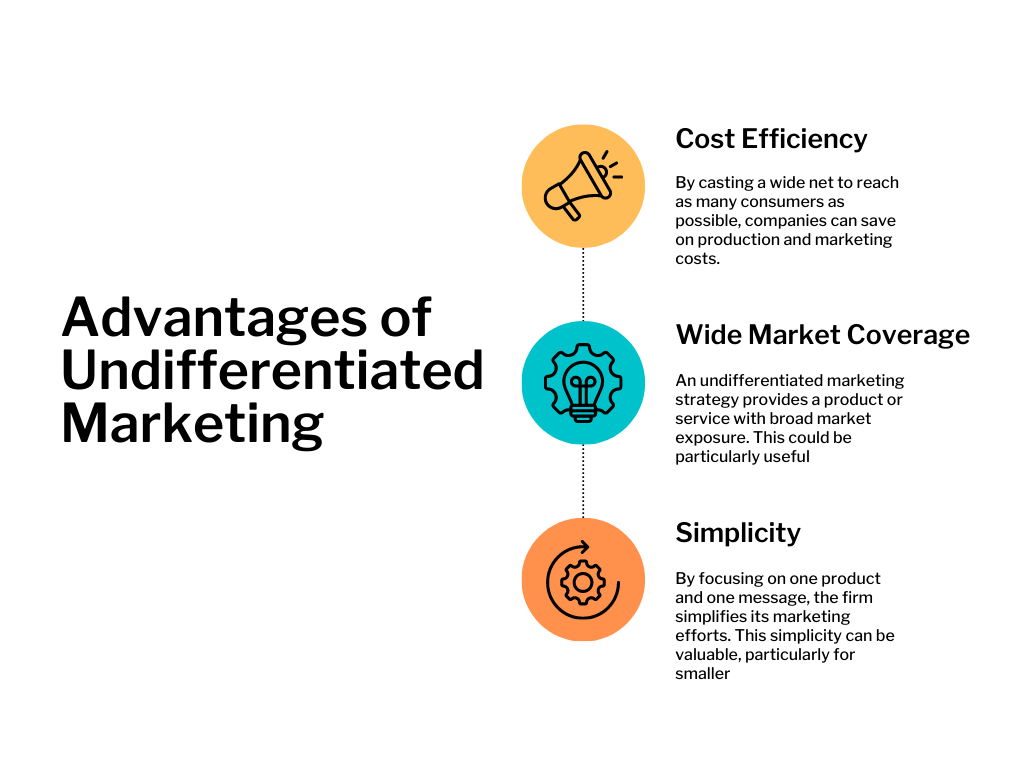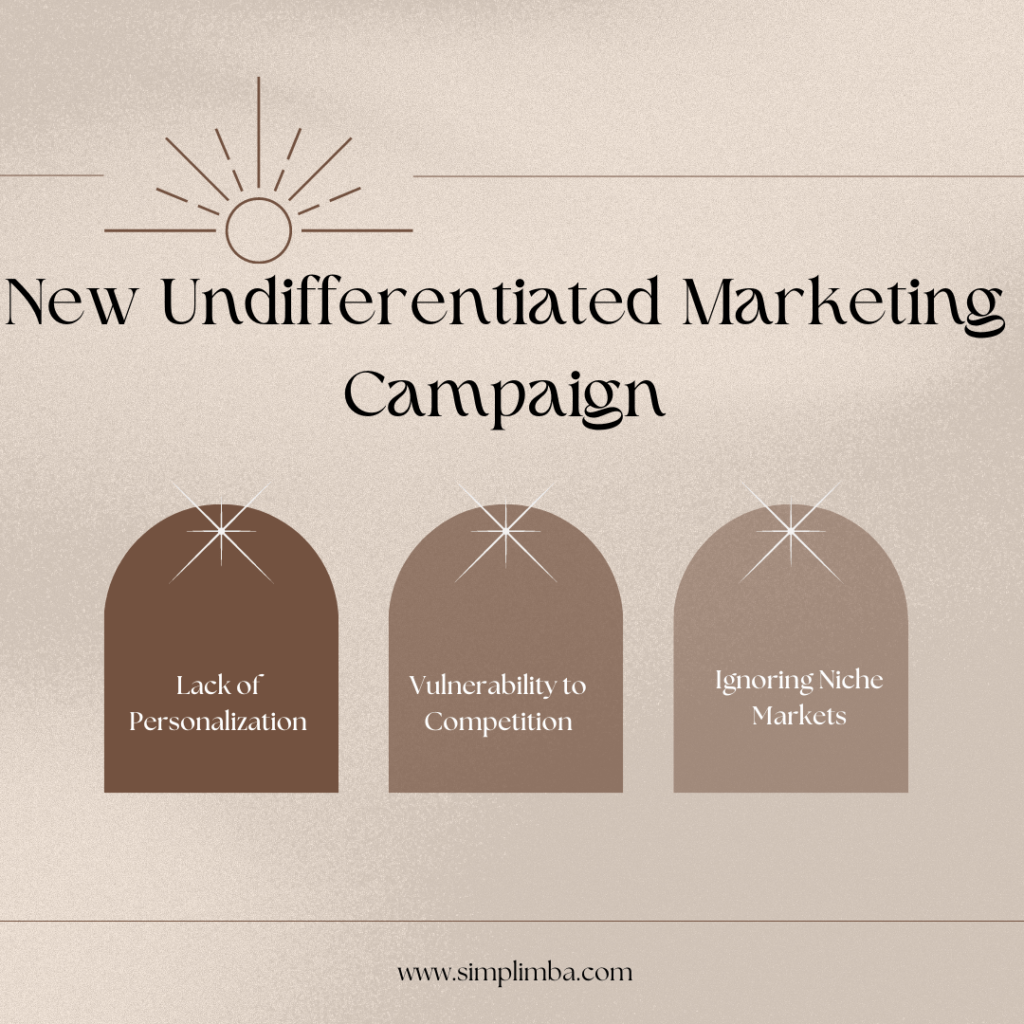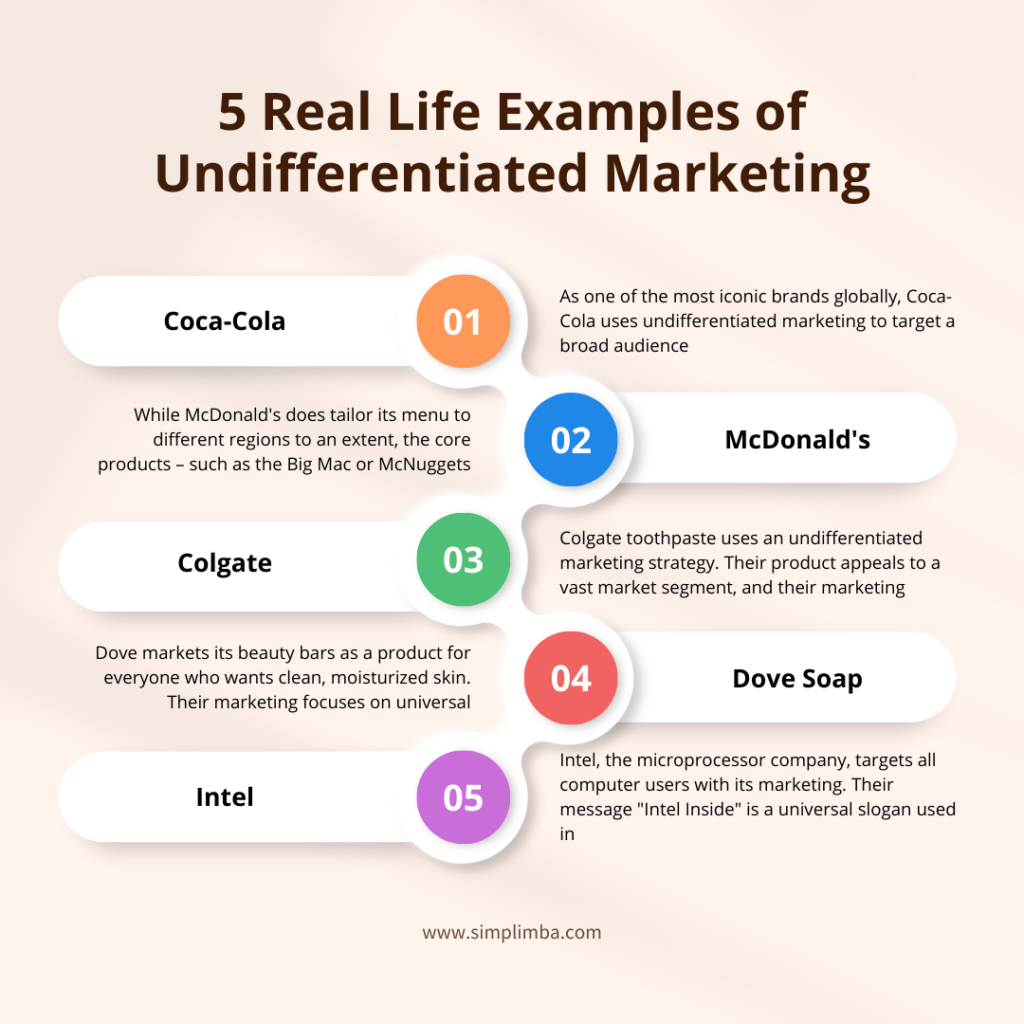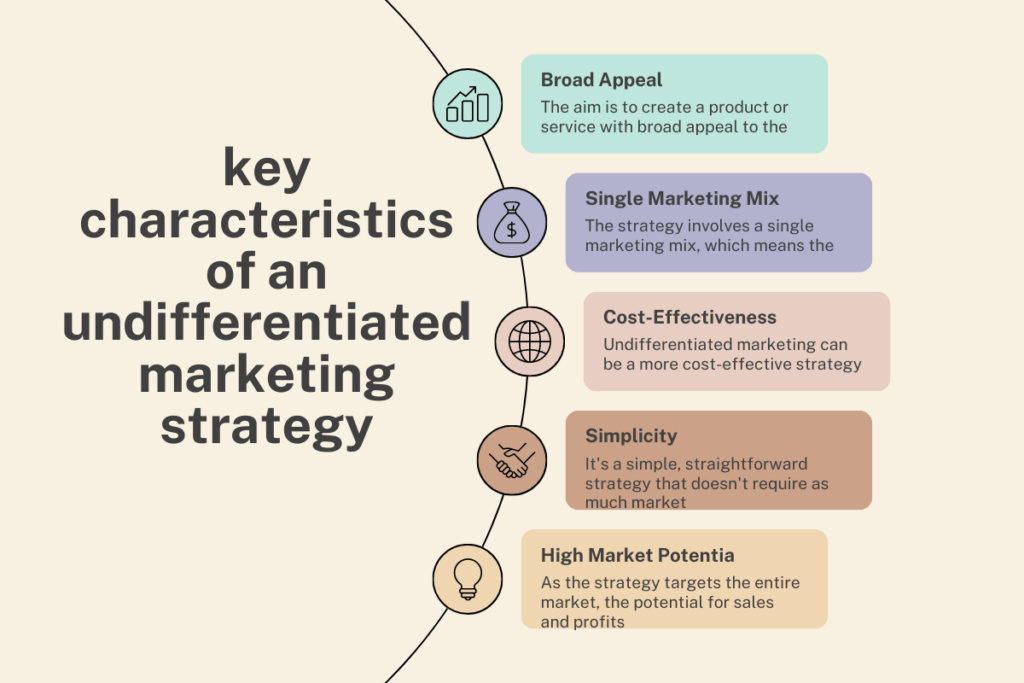Introduction
Undifferentiated-marketing, also known as mass marketing or market aggregation, is a marketing strategy where a company views the market as a homogenous group and chooses to promote its products or services to the entire market with a single marketing mix. This approach operates on the premise that individual customer needs and preferences within the market are essentially similar.
What is Undifferentiated Marketing? – Definition
Rather than segmenting the market into different groups with varying needs and desires, companies adopting an undifferentiated-marketing strategy choose to focus on what is common in the needs of consumers. They aim to design a product that will have a universal appeal and couple it with marketing messages that are broadly attractive. This method can lead to significant cost savings in production, distribution, and promotion.
The Fundamentals of Undifferentiated Marketing Strategy
Undeniably, an effective undifferentiated marketing strategy is pivotal in the success of any product or service in the market. But what is an undifferentiated-marketing strategy, and why should businesses consider this approach?
Understanding Undifferentiated Marketing Strategy
Simply put, an undifferentiated-marketing strategy, also known as mass marketing, is a method in which a firm decides to ignore market segment differences and appeal to the entire market with one offer or one strategy. The crux of this strategy is that the same basic product is offered to all customers, providing a clear answer to the frequently asked question, “What is undifferentiated-marketing?”
Key Characteristics of an Undifferentiated Marketing Strategy
Undifferentiated marketing strategy, by definition, is characterized by its broad and inclusive approach. A company may use an undifferentiated-marketing strategy to promote its products when it perceives a universal demand or broad appeal for its product. An apt example of undifferentiated-marketing is the production and sale of staple food products like rice or bread.
Further, undifferentiated-marketing is more suited for products that don’t require a lot of customization, and where consumer needs and preferences are relatively uniform. For instance, the best choice of product to market using an undifferentiated-marketing strategy would be a product that everyone uses, like toothpaste or soap.
On the other hand, compared with undifferentiated-marketing, differentiated marketing is more likely to lead to more personalized marketing messages and tailored offerings, but may also lead to higher marketing costs. The differentiated and undifferentiated marketing strategies should be chosen based on the product, the market, and the resources of the company.
Moreover, while it has many benefits, there are also undifferentiated-marketing disadvantages to consider. The main drawback of launching a new undifferentiated marketing campaign can be the lack of personalization or customization that some customers may be seeking.
Despite these challenges, when used appropriately, undifferentiated-marketing can offer companies cost efficiencies in advertising and production while reaching a large customer base. But the key is understanding when this strategy is the right fit – a firm should use undifferentiated marketing to promote its products when it is targeting a broad market with similar needs and wants, or when the product or service itself has universal appeal.
These can considered as a condensed summary of key characteristics of an undifferentiated marketing strategy:

Broad Appeal: The aim is to create a product or service with broad appeal to the entire market rather than catering to individual tastes or preferences.
Single Marketing Mix: The strategy involves a single marketing mix, which means the same product, distribution method, promotion, and pricing strategy are used for all consumers in the targeted market.
Cost-Effectiveness: Undifferentiated marketing can be a more cost-effective strategy because it avoids the costs associated with tailoring marketing mixes for different market segments.
Simplicity: It’s a simple, straightforward strategy that doesn’t require as much market research or data analysis as differentiated or concentrated marketing strategies.
High Market Potential: As the strategy targets the entire market, the potential for sales and profits can be high, assuming the product or service does have broad appeal.
Advantages and Disadvantages of Undifferentiated Marketing
What Are the Advantages of Undifferentiated Marketing?
Undifferentiated marketing offers several distinct advantages, which makes it a viable strategy for certain products and markets.

Cost Efficiency: By casting a wide net to reach as many consumers as possible, companies can save on production and marketing costs. The efficiencies arise from the fact that with undifferentiated marketing, the same basic product is offered to all customers, eliminating the need for various product versions or diverse marketing campaigns. For instance, one undifferentiated marketing example could be a company producing bottled water. The product is the same for every consumer, and the marketing message can be universal, resulting in cost savings.
Wide Market Coverage: An undifferentiated marketing strategy provides a product or service with broad market exposure. This could be particularly useful for products with universal demand or appeal, like basic utilities or everyday commodities.
Simplicity: By focusing on one product and one message, the firm simplifies its marketing efforts. This simplicity can be valuable, particularly for smaller businesses or those with limited resources.
When to Use Undifferentiated Marketing
A firm should use undifferentiated marketing to promote its products when the products are essential or largely undifferentiated themselves. Commodity products like salt or sugar, for example, are typically sold using an undifferentiated strategy because the products are essentially the same regardless of the producer.
Main Drawbacks of Launching a New Undifferentiated Marketing Campaign
Despite these advantages, it’s important to consider the potential drawbacks that come with the implementation of an undifferentiated marketing strategy.

Lack of Personalization: One major disadvantage of undifferentiated marketing is the lack of personalized offerings. In an era where consumers increasingly expect products and services to be tailored to their specific needs, a one-size-fits-all approach can be seen as impersonal or detached. This is the main drawback of launching a new undifferentiated marketing campaign – it may fail to resonate with consumers who have come to expect personalized experiences.
Vulnerability to Competition: Undifferentiated marketing offers little room for product differentiation. That means if a competitor comes along with a similar product that is somehow differentiated, customers may be drawn to the competitor’s offering.
Ignoring Niche Markets: This strategy tends to overlook niche markets. It’s like casting a wide net but failing to capture the specific fish one might be aiming for. Niche markets often have specific needs that require a more tailored or concentrated approach
Application of Undifferentiated Marketing
When it comes to the application of undifferentiated marketing, there are several examples in the business world that can be instructive. The use of an undifferentiated marketing strategy often depends on the product, market conditions, and target audience.
One common application is within industries that sell basic commodities or essential goods. For instance, salt producers often use undifferentiated marketing because the product is universal, used by nearly everyone, and doesn’t require much differentiation. The same can be said for utilities like electricity or water companies, which offer the same basic service to all consumers.
Consumer staples like rice, flour, and other basic groceries also typically use an undifferentiated marketing strategy. These are products consumed by virtually everyone, and the marketing strategy doesn’t usually need to differentiate between market segments.
One real-world example of undifferentiated marketing is the Coca-Cola company. The classic Coca-Cola drink is marketed the same way across all markets. The company uses similar advertisements and promotions globally, reinforcing the same brand image of joy, unity, and refreshment. This is an example of a global undifferentiated marketing strategy, which suggests that the appeal of the product is universal.
However, it’s worth noting that not all companies or products will benefit from an undifferentiated approach. Undifferentiated marketing is more suited for products that have a wide, general appeal and don’t require much customization.
In contrast, for products that cater to specific customer needs, desires, or preferences, a differentiated or concentrated marketing approach might be more suitable. For example, a luxury car company would likely need to differentiate its marketing efforts to target different consumer groups with varying preferences and buying power.
A company considering an undifferentiated marketing strategy should carefully weigh the benefits and potential drawbacks, analyze the nature of the product and the market, and consider whether a broad appeal or a tailored approach would be most effective. The ultimate goal is to align the marketing strategy with the company’s overall objectives, and product offerings, and target customers’ needs and preferences.
Which Products are Most Likely to Use and Benefit from Undifferentiated Marketing?
Certain products and services lend themselves better to undifferentiated marketing than others. Typically, those goods and services that are universally needed or used, and do not require much customization or personalization, are most suited for an undifferentiated marketing strategy.
Staple Goods: Commodities like rice, wheat, salt, or sugar are perfect examples of products that benefit from undifferentiated marketing. These are items that are used by a wide population, and the demand for these products doesn’t vary significantly between different market segments.
Utilities: Services like water, electricity, and basic telecommunication services can also benefit from undifferentiated marketing. Since these services are used uniformly by all consumers, there is no need for a differentiated marketing approach.
Basic Hygiene Products: Items such as soap, toothpaste, and detergent are used by virtually all households. While there can be some degree of segmentation (e.g., toothpaste for sensitive teeth or soap for dry skin), the broad appeal of these products makes them suitable for an undifferentiated marketing strategy.
Mass-produced Snacks: Snack food items like chips or soda often use undifferentiated marketing. While there may be different flavors, the overall product appeal is broad, and the same marketing message can resonate with a large consumer base. A classic example is Coca-Cola’s marketing, which reinforces universal themes of happiness and refreshment.
However, it’s crucial to remember that while undifferentiated marketing can be a cost-effective and efficient strategy for these types of products, it might not be suitable for all products or services. Products that are intended for a specific niche, have a high degree of personalization, or cater to a specialized need often require a differentiated or concentrated marketing approach.
A company should carefully consider the nature of its product, the diversity of the potential market, and its overall business goals when deciding on an undifferentiated marketing strategy.
Undifferentiated Marketing vs Other Marketing Strategies
The Difference Among Undifferentiated, Concentrated, and Differentiated Marketing Strategies
When it comes to effective marketing, one size doesn’t fit all. Depending on a company’s specific situation, product offering, and target market, different marketing strategies can be adopted. These include undifferentiated marketing, differentiated marketing, concentrated (or niche) marketing, and micro marketing. Each strategy has its unique attributes, benefits, and drawbacks, and understanding these can guide a company in crafting the optimal marketing approach for its needs. In the upcoming sections, we’ll delve into a detailed comparison of undifferentiated marketing with other prevalent marketing strategies.
Concentrated vs Undifferentiated in Marketing
| Criteria | Concentrated Marketing | Undifferentiated Marketing |
| Targeting Strategy | Concentrated marketing involves targeting a specific, well-defined segment of the market. This could be a particular demographic, psychographic, geographic segment, or a niche market. | In contrast, undifferentiated marketing aims at the entire market with a single offering. The same basic product and promotional message are offered to all customers in the market. |
| Product and Promotion | With a concentrated approach, the product and promotional strategies are tailored to meet the specific needs and wants of the targeted segment. The aim is to create a strong market presence within this niche. | In undifferentiated marketing, the product and promotional strategies are standardized. The same basic product and promotional message are offered to all customers, regardless of their individual needs or preferences. |
| Benefits | Concentrated marketing can lead to strong brand loyalty and premium pricing, as the product is perceived as specifically designed for the target group. It can also be cost-effective by focusing resources on a specific market segment. | Undifferentiated marketing can be cost-effective due to economies of scale in production and promotion. It also ensures broad market coverage, potentially reaching a larger number of consumers. |
| Drawbacks | The main risk of concentrated marketing is dependence on a single market segment. If demand in this segment declines or competition increases, the company could be vulnerable. | Undifferentiated marketing might fail to meet the specific needs of different consumer groups. In a market where consumers are increasingly seeking personalized experiences, a one-size-fits-all approach might lead to decreased customer satisfaction and loyalty. |
| Best Suited for | This strategy is best suited for specialized products, luxury items, or when entering a new market with established competitors. | This strategy is more suited for mass consumption products with broad appeal, such as basic groceries, utilities, or staple goods. |
It’s essential to note that while concentrated and undifferentiated marketing are distinct strategies, many companies employ a mix of different marketing strategies based on the diversity of their products and the markets they serve. The decision to use a particular approach should align with the company’s overall objectives, product offering, and market understanding.
Case Studies and Practical Insights
5 Real Life Examples of Undifferentiated Marketing

- Coca-Cola: As one of the most iconic brands globally, Coca-Cola uses undifferentiated marketing to target a broad audience. The company’s promotional messages of refreshment and unity are universal, and their primary product – the classic Coca-Cola beverage – is the same no matter where it’s purchased. This is a prime example of undifferentiated marketing.
- McDonald’s: While McDonald’s does tailor its menu to different regions to an extent, the core products – such as the Big Mac or McNuggets – are marketed in the same way across all regions. The iconic “I’m lovin’ it” slogan is used globally, marking an undifferentiated marketing strategy.
- Colgate: Colgate toothpaste uses an undifferentiated marketing strategy. Their product appeals to a vast market segment, and their marketing strategies generally focus on universal aspects of dental hygiene and health. This is another effective example of undifferentiated marketing.
- Dove Soap: Dove markets its beauty bars as a product for everyone who wants clean, moisturized skin. Their marketing focuses on universal themes of beauty and self-care, which appeals to a broad consumer base, an example of an undifferentiated marketing strategy.
- Intel: Intel, the microprocessor company, targets all computer users with its marketing. Their message “Intel Inside” is a universal slogan used in all promotional materials, making it an excellent example of undifferentiated marketing.
In each of these cases, the company has chosen to use undifferentiated marketing to promote its products when the appeal of the product is broad and universal. This strategy allows these companies to reach a wide audience, promote a consistent brand image, and achieve economies of scale in production and marketing.
Conclusion
The world of marketing is vast and diverse, with myriad strategies to choose from based on a company’s unique product offering, market conditions, and business objectives. Undifferentiated marketing is one such strategy, which, when applied correctly, can yield substantial benefits.
Companies such as Coca-Cola, McDonald’s, and Dove have utilized an undifferentiated marketing strategy successfully to appeal to a broad customer base and create a universal brand image. This approach, which emphasizes wide reach and standardized messaging, is particularly effective for products with a wide appeal, such as staple goods, basic hygiene products, and mass-produced snacks.
However, like any marketing approach, undifferentiated marketing comes with its own set of challenges and limitations. In a world where customers increasingly value personalization and unique experiences, a one-size-fits-all approach may not always resonate. Therefore, a company considering undifferentiated marketing should thoroughly analyze the nature of its product, the characteristics of its target market, and its overall business objectives.
Marketing strategies aren’t always mutually exclusive, and many companies employ a mix of different approaches based on their diverse product lines and markets. Regardless of the approach chosen, the key is to ensure that it aligns with the company’s overarching goals and resonates with the target customers’ needs and preferences.
Samrat is a Delhi-based MBA from the Indian Institute of Management. He is a Strategy, AI, and Marketing Enthusiast and passionately writes about core and emerging topics in Management studies. Reach out to his LinkedIn for a discussion or follow his Quora Page

